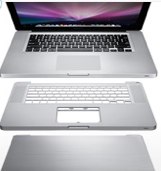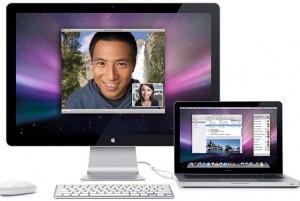Reflecting on Apple's Laptop Event
On the face of it, Apple’s recent laptop event was fairly straight forward. They refreshed the entire line-up of laptops and introduced a new Cinema Display. But dig a little deeper, and it’s obvious that much was said “between the lines”.
We’re not the market, don’t punish us for their mistakes
As is usual for these events, the opening concentrated on Apple’s current performance. Growth, making headway in the market and hitting targets were all touched upon. What really stood out though, was the focus on how Apple is consistently out performing the market. They were also keen to point out that in higher education, they have surpassed Dell as the leading supplier of laptops.
So why were they keen to disseminate these two specific pieces of information? As I see it, there are two very obvious reasons.
- Firstly, they don’t want to be tied to the current market. By highlighting the fact that Macs are consistently growing faster than the overall computer market, they are trying to insulate themselves from the current problems the market is experiencing. Given the present financial difficulties around the world, it’s expected that people will be more hesitant when it comes to purchasing/replacing computers. Apple is trying to convince us that this potential slowdown will not effect them as much as other manufacturers. They don’t want to be tarred with the same brush.
- Secondly, it’s quite possible that Apple were preparing us for the prices they were about to announce. By dropping the price of the white polycarbonate MacBook to £719 and introducing the new Aluminium MacBook at £949 it’s clear that Apple would not be meeting analyst’s expectations on price. You can buy a laptop from Dell for £399, it can be tough to stomach the base Apple laptop costing almost twice as much. However, by making it clear that their current pricing strategy is working (and, by implication, working better than the rest of the industry), and that they are successfully targeting certain areas of the market, Apple were trying to deflect any criticism in advance. It’s difficult to criticise Apple’s pricing strategy when it’s producing growth for the company that’s comfortably bettering the competition. And to be perfectly honest, Apple’s prices feel right. They aren’t competing with the £399 Dell laptop, and that’s obvious once you’ve experienced both pieces of hardware.
Steve Jobs isn’t a Highlander
The aforementioned introduction was covered by Tim Cook, Apple COO. Following that, Jonny Ive described the new manufacturing process. Steve Jobs was used carefully, which is something of a recent trend. In some quarters, this has been seen as Jobs making a conscience effort to introduce the public (and more importantly, the media, investors and analysts) to some of the team. The aim has to be two fold. Firstly, to negate the effect of Jobs’s eventual departure. Even if Jobs intends to stay on for five years, confidence will only remain if people are comfortable and familiar with the men and women that will step into his place. This can’t happen overnight, it takes time. Secondly, rumours of Jobs’s ill-health have had dramatic effects on the share price of Apple. Steve, and the rest of the company, cannot afford to let this happen. Overall, Apple need to, at least in public, reduce the perceived reliance on a single figure head. The overall vision for Apple needs to belong to the company, not to Steve Jobs.
The big question will be, who can replace Steve Jobs? The obvious choice would no doubt be Tim Cook. We (as in Apple fans) know him fairly well, and he’s perceived as a fairly safe pair of hands. However, I can see Jonny Ive stepping into Steve Jobs’s role as figure head and visionary. Along with Jobs he’s seen as one of the reasons the Apple’s rebirth and continued resurgence. He’s also a very well known character and has the staggering attention to detail and near fanaticism about design and quality that typify Apple. He’s also seen, much like Jobs, as a one-off, one-of-a-kind guy. Some that competitors simply don’t have.
A-Loo-Min-Um?
 For a media event, Apple spent a significant amount of time describing the new manufacturing process they’ve devised for the new laptops. Throwing words like “unibody” and “milling” around, Apple seemed confident that the audience would be impressed. But what were they really trying to convey to the audience? Why go to all that trouble? It’s clear that they are setting the stage for something else. By announcing that this new process allows for devices like the MacBook Air to be produced, Apple are announcing to the world that they have the fundamentals in place for mass producing extremely thin, strong enclosures. It’s a signal of intent, and the intent may be a tablet or a netbook, two pieces of hardware that would necessitate such a manufacturing process.
For a media event, Apple spent a significant amount of time describing the new manufacturing process they’ve devised for the new laptops. Throwing words like “unibody” and “milling” around, Apple seemed confident that the audience would be impressed. But what were they really trying to convey to the audience? Why go to all that trouble? It’s clear that they are setting the stage for something else. By announcing that this new process allows for devices like the MacBook Air to be produced, Apple are announcing to the world that they have the fundamentals in place for mass producing extremely thin, strong enclosures. It’s a signal of intent, and the intent may be a tablet or a netbook, two pieces of hardware that would necessitate such a manufacturing process.
Lifestyle is Lifestyle, and other tidbits
 Apple has always been a lifestyle brand. If you sell your soul to them by dedicating yourself to Apple, then they will reward you with seamless experiences that no other brand can really match. Up until now, the lifestyle has very much been that of a consumer, a home user. Combining an iPhone, Apple TV and a Mac, you could have a seamless multimedia experience. This is a tactic that has served them well, so why not expand it to the next logical step, selling a different lifestyle. The new LED display is a lifestyle device. Except they are selling a seamless professional lifestyle. Many laptop users who use external displays (myself included, in my day job I have a Lenovo T Series laptop hooked up to a 19 inch Dell display) hate the inconvenience of having to swap cables out and all the fiddly problems that go with it. Apple are selling convenience and seemlessness. Make no mistake, there won’t be many consumers wanting to pay £649 for a cinema display. Mac using managers up and down the country are rubbing their hands though.
Apple has always been a lifestyle brand. If you sell your soul to them by dedicating yourself to Apple, then they will reward you with seamless experiences that no other brand can really match. Up until now, the lifestyle has very much been that of a consumer, a home user. Combining an iPhone, Apple TV and a Mac, you could have a seamless multimedia experience. This is a tactic that has served them well, so why not expand it to the next logical step, selling a different lifestyle. The new LED display is a lifestyle device. Except they are selling a seamless professional lifestyle. Many laptop users who use external displays (myself included, in my day job I have a Lenovo T Series laptop hooked up to a 19 inch Dell display) hate the inconvenience of having to swap cables out and all the fiddly problems that go with it. Apple are selling convenience and seemlessness. Make no mistake, there won’t be many consumers wanting to pay £649 for a cinema display. Mac using managers up and down the country are rubbing their hands though.
Following on from that, I can see some more “professional lifestyle” products coming from Apple. Devices to bridge existing gaps and provide an even smoother Mac using experience.
Another interesting trend is that of design. Apart from the extant White Polycarbonate MacBook, Apple now have a very clear, very strong, universal brand identity. I’d expect some minor changes to iMacs and the remaining cinema displays shortly to fall in line with these subtle design tweaks (expect the bottom, current aluminium, portion of the iMac to shrink, and the glass to grow). And the same goes for the Apple TV, AirPort Base Stations and Time Capsule. Apple aren’t known for doing things half way.
So what did you get out of the event? Anything I’ve missed?



Great post Simon – really well thought out 🙂
The new machines in the flesh are just superb – OOZE quality. I *think* I am going to get a new 15″ MBP and then wait for the netbook as well. I was set on an Air, but compared to both the new MB and MBP, it feels dated, really!